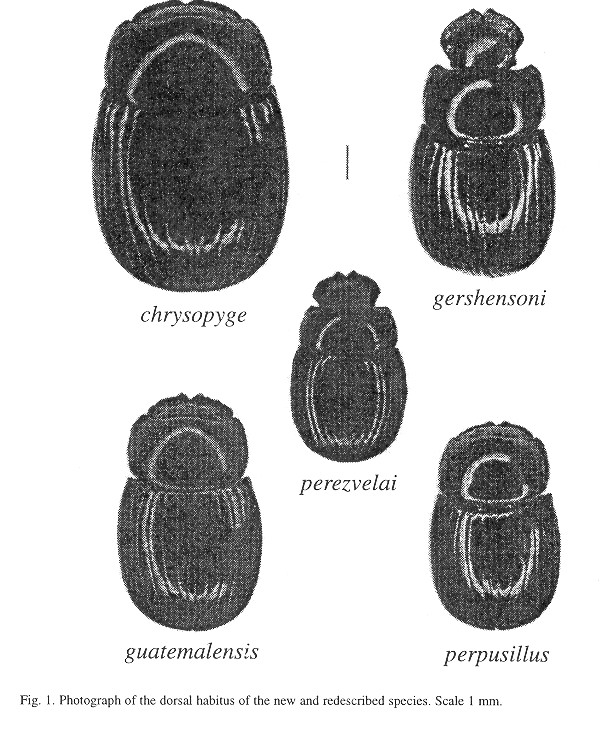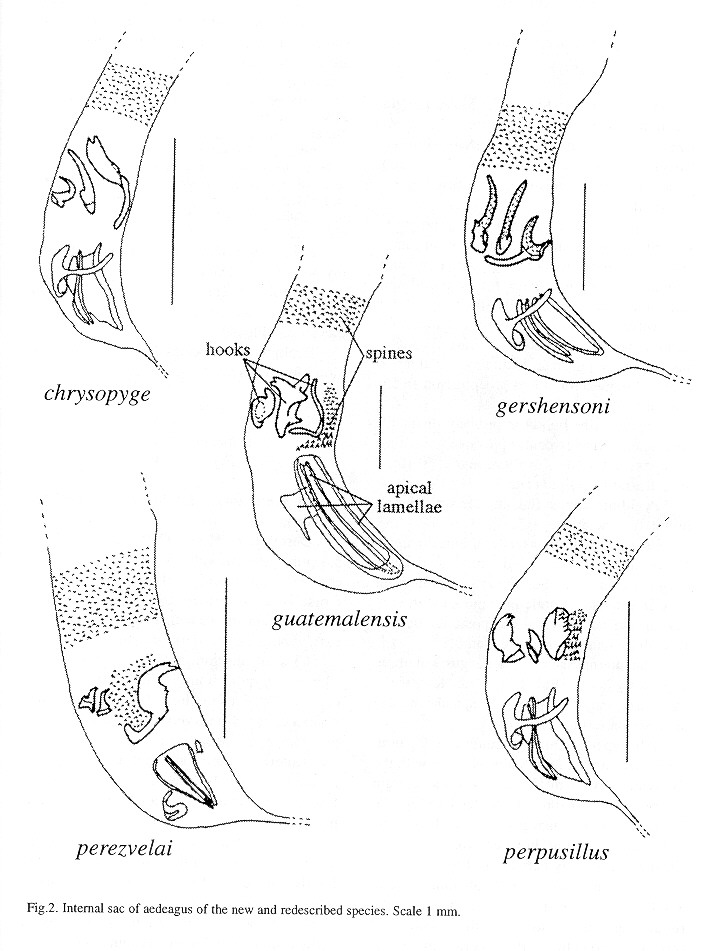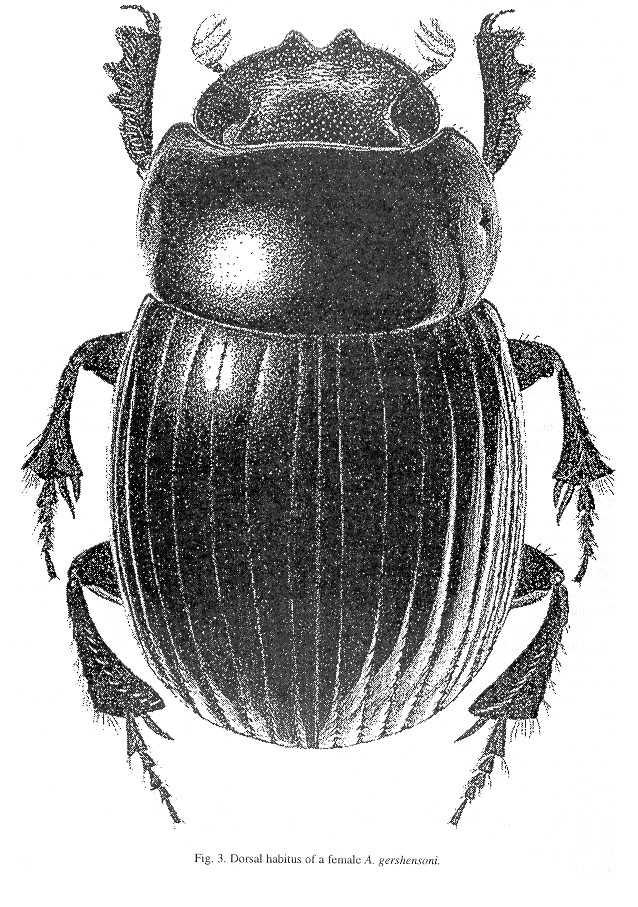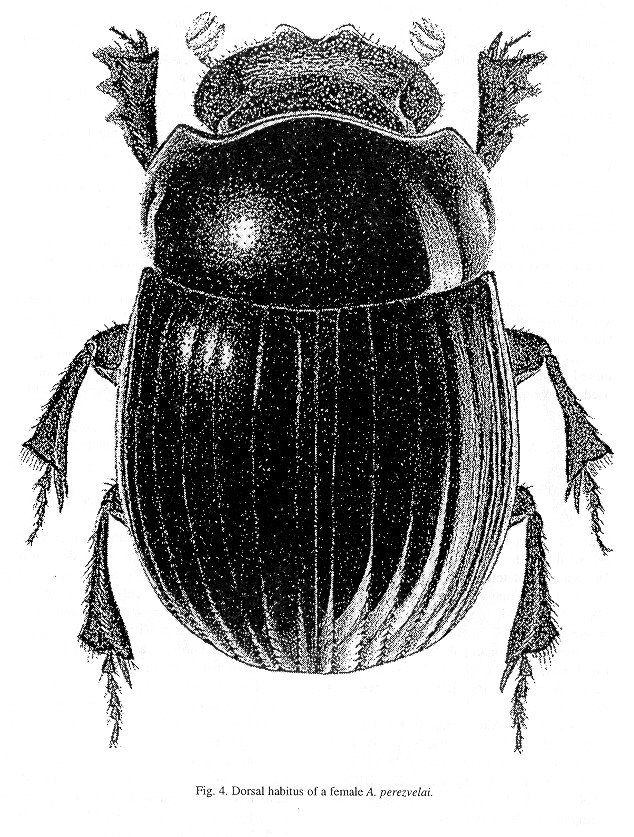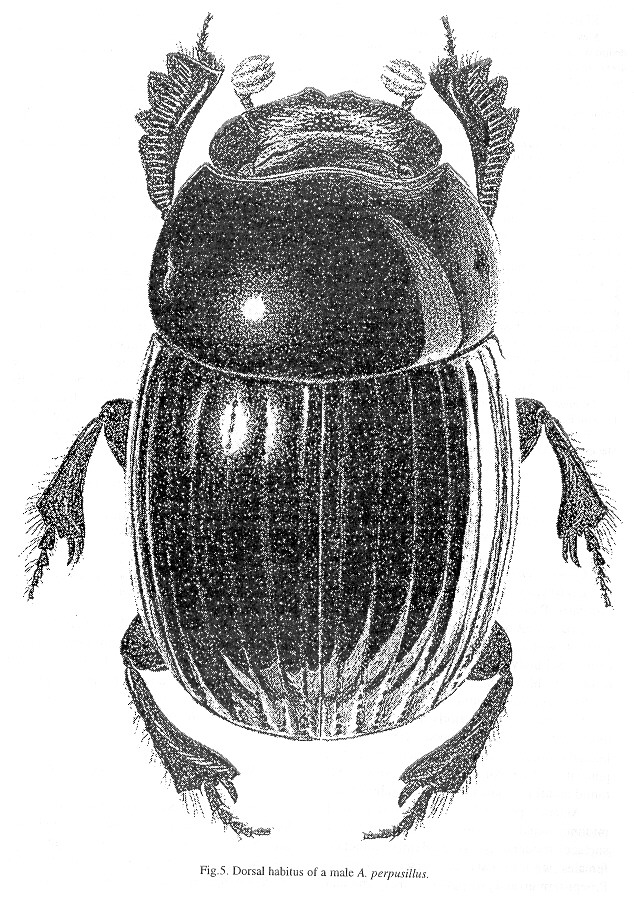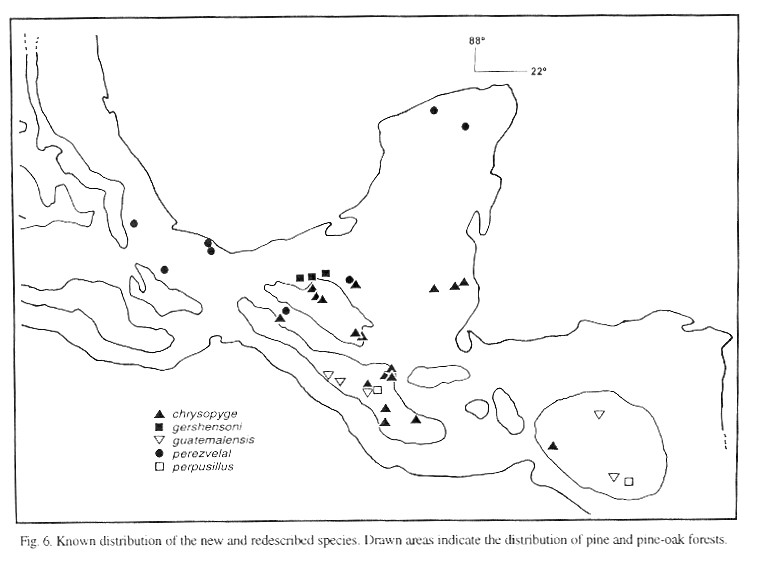Revista de Biología Tropical
versión On-line ISSN 0034-7744versión impresa ISSN 0034-7744
Rev. biol. trop vol.48 no.1 San José mar. 2000
(Coleoptera:Scarabaeidae)
Bert Kohlmann. 1
Received 19-IV-1999. Corrected 21-X-1999. Accepted 28-X-1999.
Abstract
This paper describes three new species of Ateuchus for Mesoamerica. The new taxa are: A. gershensoni (copulatory hooks subequal in size and spinelike), A. perezvelai (small size; frons very convex; one very big copulatory hook and two small spine-like ones associated with a spiny fascies) and A. perpusillus (anterior pronotal margin incomplete; small and compact copulatory hooks, associated with a spiny fascies) from southern Mexico, Guatemala and Honduras. Redescriptions are also given for A. chrysopyge (Bates) (big size; copulatory hooks, one big, a spine-like medium-sized one and a hook-like small one) and A. guatemalensis (Bates) (pronotum punctured; anterior pronotal margin almost effaced; pygidium convex; copulatory hooks, two small and compact and one very thin and curved). New country and distributional records are also registered for Mexico, Guatemala, Belize, Honduras and El Salvador. Distribution map, internal sac of aedeagus illustrations and photographs of dorsal habitus are included, as well as drawings of the dorsal habitus of the three new species. The present work clarifies the situation of the genus in Mesoamerica and updates knowledge of the group in Mexico.
Key words
Ateuchus, Scarabaeinae, dung beetles, Coleoptera, new species, Neotropical, Mesoamerica
This work is an extension of the work originally done on North American Ateuchus (Kohlmann 1984). It describes three new species from the Mesoamerican area. The new taxa are: A. gershensoni, A. perezvelai and A. perpusillus. It also reports new country and distribution records for Mexico, Guatemala, Belize, Honduras and El Salvador.
This paper attempts also to partially update the knowledge of the North American Ateuchus fauna (Kohlmann 1984), by reporting the presence of four more species in Mexico (two new species, A. gershensoni and A. perezvelai; and two new country records, A. chrysopyge (Bates) and A: guatemalensis (Bates)) and thus increasing the number of previously known species from this country from eight to twelve. The paper also enlarges the distribution of previously recorded species in Mexico.
A redescription of A. chrysopyge and A. guatemalensis is also given. Since their original description by Bates (1887) no one had reported any information regarding any of the two species. Together with previous information from Costa Rica (Kohlmann 1996-97) and Panama (Howden and Young 1981), this paper is filling a knowledge gap of the Mesoamerican area, although Nicaragua still remains largely unknown.
Mesoamerican Ateuchus species closely resemble each other and many times it is very difficult to separate them solely on the ground of external morphology. Natural variation compounds this problem further. Without the aid of the analysis of the internal sac of the aedeagus, identification of many species would rest on shaky ground. It is therefore that the internal sacs of all species have to be studied and depicted, as is the case here with these previously unknown taxa and the redescribed ones.
Materials and Methods
Specimens came from my personal collection, as well as from the H.F. Howden, Ottawa, Canada; M.A. Morón and C. Deloya, Instituto de Ecología, Xalapa, México and R. Cave, Escuela Agrícola Panamericana, El Zamorano, Honduras.
The specimens were studied using a stereozoom binocular microscope. Measurements were made to the nearest 0.1 mm using an ocular micrometer. Genital dissections and preparations were done following the techniques described by Zunino (1978).
Types and paratypes of the new species are deposited at the Canadian Museum of Nature, Ottawa.
NEW SPECIES
Ateuchus gershensoni n. sp.
Figs. 1-3, 6
Description- HOLOTYPE. Male. Length 7.4 mm, greatest width 4.7 mm. Medium-sized, convex, oval-ovoid body shape (Fig. 1). Dorsally dark brown to black, head and pronotum with a reddish-greenish cast, ventral surface dark brown.
Clypeal margin anteriorly broadly V-shaped, clypeal margin laterally arcuate, clypeal border moderately punctate and wrinkled, frons and vertex feebly tumid and finely punctate, eyes dorsally small.
Anterior pronotal margin complete; midline weakly impressed at base, pronotal surface finely punctate, including the anterior angles. Proepisternum and proepimeron finely granular.
Elytral striae lightly impressed, distinctly so at apex, striae evidently punctate, crenating at apex, intervals feebly convex, surface smooth and finely punctate.
Pygidium almost flat, surface smooth and minutely punctate.
Foretibia with four teeth on outer margin, foretibial spur expanded into a slightly irregular oval shape. Foretibiae and forefemora long and slender. Forefemur smooth with very few coarse punctures at the posterior border. Last abdominal segment slender.
The internal sac of the aedeagus with three copulatory hooks (Fig. 2), more or less of the same size and spine-like. The apical lamellae are also three (Fig. 2).
Allotype- Female. Length 6.9 mm, greatest width 4.4 mm. Same as male, with the following sexual differences: clypeal margin anteriorly, not so broadly V-shaped (Fig. 3); lateral pronotal margin not arched; last abdominal segment broader; foretibial spur slender and slightly bent at tip (Fig. 3).
Variation: Length: 6.9-7.4 mm. Width: 4.4-4.7 mm. Some specimens do not show the reddish-greenish cast on the head and pronotum; sometimes the anterior margin is not so evident, although it does not become effaced; pronotal surface in some cases with some coarser punctures along the basal and anterior margins.
Type material-
Holotype. Male. Mexico: Chiapas: 20 mi N Bochil, 24/VIII/1971, 5600', A. Newton. Allotype. Female. Same data as holotype.
Parataypes. Mexico: Chiapas: Ocosingo, 6/IX/1947, 1200 m, zona montañosa, bosque primitivo, M. del Toro, (1 specimen); 6.6 mi W El Bosque, 25-29/VIII/1973, 4800', cloud forest, A. Newton, (1); Finca Trinidad, Mpio. El Bosque, 4/IX/1981, 1450 m, bosque mesófilo, P. Reyes, G. Quintero, J. Valenzuela, (1).
Etymology: This species is named after my good friend, Daniel Gershenson.
Chorology: The species is only known from the mountains of Chiapas at mid-elevations (Fig. 6).
Ecology: The species has been found in cloud forest only.
Ateuchus perezvelai n. sp.
Figs. 1, 2, 4, 6
Ateuchus klugi (Harold), Kohlmann 1984 (in part).
Description- HOLOTYPE. Male. Length 5.5 mm, greatest width 3.5 mm. Small-sized, convex, oval-ovoid body shape (Fig. 1). Dorsally dark brown to black, head and pronotum sometimes with a very faint greenish cast, ventral surface dark brown.
Clypeal margin anteriorly broadly V-shaped, clypeal margin laterally arcuate, clypeal border moderately punctate and wrinkled, frons and vertex tumid and finely punctate, eyes dorsally small.
Anterior pronotal margin complete; midline completely effaced, pronotal surface finely punctate. Proepisternum and proepimeron finely granular.
Elytral striae very lightly impressed, somewhat more impressed at apex, striae lightly punctate, slightly crenating at apex; intervals feebly convex, surface smooth and very finely punctate. Pygidium lightly convex, surface smooth and minutely punctate.
Foretibia with four teeth on outer margin, foretibial spur expanded into a slightly irregular oval shape. Foretibiae and forefemora short and stout. Forefemur smooth with very few coarse punctures at apex. Last abdominal segment slender.
The internal sac of the aedeagus has three copulatory hooks (Fig. 2), one big and two smaller ones. The apical lamellae are also three (Fig. 2).
Allotype: Female. Length 5.5 mm, greatest width 3.5 mm. Same as male, with head and pronotal punctures more evident and a more convex pygidium and with the following sexual differences: clypeal margin anteriorly, not so broadly V-shaped (Fig. 4); lateral pronotal margin not arched; last abdominal segment broader; foretibial spur slender and slightly bent at tip (Fig. 4).
Variation: Length: 4.8-5.5 mm. Width: 2.9-3.5 mm. Some specimens do not show the reddish-greenish cast on the head and pronotum; the pronotal surface can be more evidently, but still finely punctate.
Observations: Some specimens of this new species appeared recorded as A. klugi in Kohlmann (1984). These were female specimens which are always difficult to identify and which can be easily confused with the females of A. klugi. The following specimens cited as klugi in Kohlmann (1984) belong to this new species: El Suspiro and Lacanjá-Chansayab, Chiapas and Temax, Yucatán.
Type material- Holotype. Male. Mexico: Yucatán: 2 km E Chichén-Itzá, 20/V/1983, 20 m, seas. for. litter, S. & J. Peck. Allotype. Female. Same data as holotype.
Paratypes. Mexico: Chiapas: El Suspiro, 12 km NW de Berriozábal, 1000 m, 2/XI/1974, selva tropical húmeda, cebo pescado, J. Mateu, (1), Lacanjá-Chansayab, 25/I/1977, 300 m, selva tropical, P. Reyes, (1), Oaxaca: 9 mi N Valle Nacional, 100', 1/VIII/1971, A. Newton, (2); Veracruz: Lake Catemaco, 1200', 31/VII-4/VIII/1970, A. Newton, (1), 8 mi NW Sontecomapan, 500', 31/VII-4/VIII/1970, A. Newton, (1), Río Metlac, 3200', 1/VIII/1973, A. Newton, (1); Yucatán: 2 km E Chichén-Itzá, 20/V/1983, 20 m, seas. for. litter, S. & J. Peck, (3); Temax, Gaumer, B.C.A. 45.3, (1).
Etymology: This species is named after my good friend Juan Antonio Pérez-Vela.
Chorology: The species seems to be distributed in south-east Mexico at low and mid-altitudes (Fig. 6).
Ecology: The species has been found in tropical evergreen and tropical deciduous forest as well.
Ateuchus perpusillus n. sp.
Description- HOLOTYPE. Male. Length 6.4 mm, greatest width 3.0 mm. Small-sized, convex, oval-ovoid body shape (Fig. 1). Dorsally dark brown to black, head and pronotum with a very evident reddish-coppery cast (Fig. 5), ventral surface dark brown.
Clypeal margin anteriorly broadly V-shaped (Fig. 5), clypeal margin laterally arcuate, clypeal border moderately punctate and wrinkled, frons and vertex slightly tumid and finely to moderately punctate, eyes dorsally small.
Anterior pronotal margin incomplete; midline only evident at base, pronotal surface finely punctate, a few coarse punctures present at anterior angles and basal margin. Proepisternum and proepimeron finely granular.
Elytral striae very lightly impressed, somewhat more impressed at apex, striae lightly punctate, slightly crenating at apex; intervals feebly convex, surface smooth and very finely punctate. Pygidium protruding pyramidally, surface smooth and minutely punctate.
Foretibia with three teeth on outer margin, foretibial spur expanded into a slightly irregular oval shape. Foretibiae and forefemora short and stout. Forefemur smooth with very few coarse punctures at apex. Last abdominal segment slender.
The internal sac of the aedeagus has three small copulatory hooks (Fig. 2). The apical lamellae are also three (Fig. 2).
Allotype. Female. Length 6.4 mm, greatest width 3.5 mm. Same as male, with head and pronotal punctures more evident and a less protruding pygidium and with the following sexual differences: clypeal margin anteriorly, not so broadly V-shaped; lateral pronotal margin not arched; last abdominal segment broader; foretibial spur slender and slightly bent at tip.
Variation: Length: 5.0-5.5 mm. Width: 3.0-3.5 mm.
Type material-
Holotype. Male. Honduras: El Paraíso: Cerro Apagius, Danlí, 28/II/1988, 900 m, R.D. Cave. Allotype. Female. Same data as holotype.
Paratypes. Guatemala: Guatemala: Zapote, Champion, (2). Honduras: El Paraíso: Cerro Apagius, Danlí, 28/II/1988, 900 m, R.D. Cave, (1).
Etymology: The name derives from the latin adjective perpusillus, meaning small.
Chorology: The species is found in mountainous areas (Fig. 6). Zapote used to be a small town that has now been engulfed by Guatemala-City.
Ecology: The species has been found in mixed-deciduous forest in Honduras; Zapote used to have oaks and pine-oak forests.
NEW COUNTRY RECORDS
Ateuchus candezei (Harold), 1868
The species was only known from the state of Chiapas, Mexico; it is now here recorded for the first time from the state of Oaxaca and Guatemala and Belize as well.
Mexico: Chiapas: Boca de Chajul, NTP-80, 28/V/1984, 110 m, selva alta subperennifolia, necrotrampa, Fragoso-Villalobos, (2); Bonampak, 8/VII/1983, 230 m, rain forest, S. & J. Peck, (1); Oaxaca: 4.5 mi S Valle Nacional, 16/VIII/1973, 1600', A. Newton, (1).
Guatemala: Alta Verapaz: Lanquín, 28-30/VIII/1969, 1000', trop. for., S. & J. Peck, (1).
Belize: Cayo: Belmopan, 11-16/VIII/1972 S. & J. Peck, (4); Augustine, 20/VIII/1972, 1500', S. & J. Peck, (1); Orange Walk: Lamanai, 22-26/II/1989, dung traps at camp, Glen Kit, (6).
Ateuchus chrysopyge (Bates), 1887
Figs. 1, 2, 6
Choeridium chrysopyge Bates, 1887. p. 44.
Lectotypes and paralectotypes: London and Paris. Paris specimens examined.
Redescription. Length 7.0-8.5 mm, greatest width 4.0-5.0 mm. Medium to big-sized, convex, oval-ovoid body shape (Fig. 1). Dorsally dark brown to black, head and pronotum sometimes with a reddish cast, ventral surface dark brown.
Clypeal margin anteriorly broadly (male,) to moderately (female) V-shaped, clypeal margin laterally arcuate, clypeal border moderately punctate and wrinkled, frons and vertex feebly tumid and finely punctate, eyes dorsally small.
Anterior pronotal margin complete, midline weakly impressed at base, pronotal surface smooth, in some cases with some coarser punctures along the basal and lateral margins, including the basal and anterior angles. Proepisternum and proepimeron finely granular.
Elytral striae lightly impressed, distinctly so at apex, striae evidently punctate, crenating at apex, intervals feebly convex, surface smooth and finely punctate.
Pygidium almost flat, surface smooth and minutely punctate.
Foretibia with four teeth on outer margin, foretibial spur of males expanded into a slightly irregular oval shape, female spur slender and slightly bent near acute apex. Foretibiae and forefemora longer and slender in males. Forefemur with coarse punctures at the posterior border. Last abdominal segment slender in males, broad in females.
The internal sac of the aedeagus has three copulatory hooks, one bigger, two smaller and very claw-like (Fig. 2). The apical lamellae are also three (Fig. 2).
Observations: The species was only known from San Gerónimo (sic, it should be San Jerónimo), Guatemala, and it is now recorded for the first time for Mexico, Belize, El Salvador and Honduras (Fig. 6).
Material examined-
México: Chiapas: Montebello, VI/1967, excr. vaca dentro de bosque, G. Halffter, (2); ibid, 14-17/VIII/1969, 4500', tropical montane forest, S. & J. Peck, (1); Comitán, 20/IX/1987, F. Arias, (4); Lacanjá-Chansayab, 23/VII/1977, 220 m, selva tropical, excr. humano, B. Kohlmann, (1); 12 mi E San Cristóbal de las Casas, 3/V/1969, H.F. Howden, (5); 9 mi SE Teopisca, Rt. 24, 3/VI/1969, H.F. Howden, (2); Laguna Bélgica, 16 km NW Ocozocoautla, 13/VI/1990, 970 m, H. & A. Howden, (4); 10 mi E Teopisca, 11-12/V/1969, H.F. Howden, (1); Lagos de Colores, Rt. 17, 1/VI/1969, H. Howden, (2).
Belize: Cayo: Caves Branch, 23-28/VIII/1972, S. & J. Peck, (1); 6 mi S Belmopan, 20/VIII/1972, litter-carrion, S. & J. Peck, (1); Augustine, 1-20/VIII/1972, 1500', S. & J. Peck, (1).
Guatemala: Baja Verapaz: 8 km S Purulhá, 27/V/1991, 1500 m, H. & A. Howden, (3); 7 km NE Purulhá, 1/VI/1991, 1500 m, H. & A. Howden, (1); 8.6 km W Chilascó, 28/V/1991, 1560 m, H. & A. Howden, (2); San Gerónimo (sic, it should be San Jerónimo), Champion, (2); Chiquimula: Fca. San José, 9/VIII/1991, 1385 m, J. Monzón, (1); Guatemala: Guatemala, 12/X/1988, trampa pitfall, R. Pérez, (1), S. J. Pinula, 28/VIII/1984, J. Melgar, (2); Petén: Tikal, 23-26/VIII/1972, dung trap, S. & J. Peck, (1); Progreso: Cerro Pinalón, Los Albores, 7/VIII/1990, 1350 m, E. Ordocia, (1).
El Salvador: Santa Ana: Monte Cristo23 km N Metapan, 8-10/V/1971, 2300 m, H.F. Howden, (6).
Honduras: La Paz: Mercedes, R.D. Cave, (1).
Ateuchus guatemalensis (Bates), 1887
Figs. 1, 2, 6
Choeridium guatemalense Bates, 1887, p. 45.
Lectotypes and paralectotypes: London and Paris. Paris specimens examined.
Redescription. Length 5.2-6.7 mm, greatest width 3.9-4.2 mm. Small, convex, oval-ovoid body shape (Fig. 1). Dorsally dark brown to black, head and pronotum with golden-green cast, ventral surface dark brown.
Clypeal margin anteriorly broadly (male) to moderately (female) V-shaped, clypeal margin laterally arcuale, clypeal border moderately punctate and wrinkled, frons and vertex feebly tumid and finely punctate, eyes dorsally small.
Anterior pronotal margin almost effaced, midline weakly impressed at base, pronotal surface moderately to evidently punctate, females tend to have a coarser punctation. Proepisternum and proepimeron finely granular.
Elytral striae lightly impressed, distinctly so at apex, striae evidently punctate, crenating at apex, intervals feebly convex, surface smooth and finely punctate.
Pygidium very big and convex, surface smooth and minutely punctate.
Foretibia with four teeth on outer margin, foretibial spur of males expanded into a slightly irregular oval shape, female spur slender and slightly bent near acute apex. Foretibiae and forefemora longer and slender in males. Forefemur with some coarse punctures apically and at the posterior border. Last abdominal segment slender in males, broad in females.
The internal sac of the aedeagus has three copulatory hooks. One of them is very peculiar in the form of a long and slender filament (Fig. 2). The apical lamellae are also three, one of them has a distinct canoe shape (Fig. 2).
Observations: The species was only known from El Tumbador (sic, it should be El Zumbador), Volcán Atitlán and Pantaleón, Guatemala and it is now recorded for the first time for Mexico and Honduras too (Fig. 6).
Material examined-
Mexico: Chiapas: Unión Juárez, 29/VI-1-2/VII/1972, ca. 3000', coffee finca, U.V light & litter, P.A. Meyer & G. Ball, (2).
Guatemala: Guatemala: Villanueva, Fca. Paraíso, 9/III/1991, Macuana, (1); San Marcos: El Tumbador (sic, it should be El Zumbador), 2500', Champion, (2).
Honduras: El Paraíso: Yuscarán, 1850 m, R.D. Cave, cloud forest, (5), Olancho: La Unión, La Muralla, 1450 m, rainforest dominated by oaks, laurels and liquidambar, R.D. Cave, (5).
Remarks. Howden and Young (1981) cited an A. (near?) guatemalensis in their work on Panamanian Scarabaeinae. Those specimens actually represented a new species, which was later described under the name of A. howdeni (Kohlmann 1996-1997).
Ateuchus laetitiae Kohlmann, 1981
This species was only known from the typical locality in Chiapas, its distribution has now been greatly expanded with the knowledge of its presence in the Mexican state of Campeche and in neighbouring Belize. The records are as follows:
Mexico: Campeche: Chicanna, 10 km W Xpujil, 12-14/VII/1983, 300 m, trop. seas. For. car. tps. S. & J. Peck, (1); Escárcega, 6 km W El Tormento, 23/VII/1983, evergreen trop. forest, fungi & litter Ber., S. & J. Peck, (2).
Belize: Orange Walk: Lamanai, 22-26/II/1980, palm forest trail, Glen Kit, (1).
NEW DISTRIBUTION RECORDS
Ateuchus carolinae Kohlmann, 1981
This is the second known locality for this species in the state of Jalisco.
Mexico: Jalisco: 9 mi NW Barra de Navidad, 17/IX/1971, 700´, A. Newton, (1).
Ateuchus halffteri Kohlmann, 1981
The species was previously known from the states of Guerrero and Morelos, it has now been found in the state of Puebla as well.
Mexico: Puebla: Tepexco (near Izúcar de Matamoros), NTP-80, 7-25/V-VI/1989, A.C. Deloya, (43); Guerrero: Acahuizotla, VI-VII/1989, 650 m, NTP-80, bosque tropical mediano subperennifolio, L. Delgado, (37).
Ateuchus illaesum (Harold), 1868
The species was previously recorded from the states of Chiapas, Hidalgo, Querétaro, San Luis Potosí and Veracruz in Mexico. There is a new state record for this species from Tamaulipas:
Mexico: Tamaulipas: Rancho El Cielo, Gómez Farías, 1-4/VII/1969, 3700', cloud forest, S. & J. Peck, (8).
Ateuchus rodriguezi (Preudhomme de Borre), 1886
Although this species was originally described from Guatemala, no precise location was given at the time. Here we give the first detailed localities for this country.
Guatemala: Escuintla: Finca Sta. Cecilia, 29/III/1991, M.E. González, (1); Guatemala: Sta. Catalina Pinula, Punta Parada, 20/II/1991, P. Broll, (1).
Ateuchus texanus (Robinson), 1948
The species is known from Texas, Tamaulipas, Nuevo León, Veracruz and San Luis Potosí. It is now recorded for the first time from the state of Querétaro.
Mexico: Querétaro: 20 mi W Xilitla, Rt. 120, 10-11/VI/1971, 5300', H. Howden, (6).
Final Remarks
From the scanty evidence of Ateuchus distribution in Mesoamerica, there seem to emerge certain patterns. A mountainous orofauna (a fauna developed in the area and representing its history) seems to occupy an area starting from southern Nicaragua to Costa Rica and Panama, with as yet not a precisely known southern limit (Kohlmann 1996-97). Another mountainous orofauna seems to be distributed from northern Nicaragua to Chiapas (A. chrysopyge, A. gershensoni, A. guatemalensis, A. perpusillus). The dry Pacific forests would represent another orofauna (A. rodriguezi). Wet Atlantic and Pacific forests have also their orofauna (A. howdeni, A. laetitiae, A. perezvelai), plus elements representing Amazonian invasions (A. aeneomicans, A.candezei). However, more information is still needed in order to clarify this situation.
Acknowledgements
I thank especially A. Solís for his help in the electronic composition of figures. I also thank H.F. Howden (Ottawa, Canada), M.A. Morón and Cuauhtémoc Deloya (Instituto de Ecología, Xalapa, México) and R. Cave (Escuela Agrícola Panamericana, El Zamorano, Honduras) for lending me their Ateuchus material. I am also grateful to Y. Cambefort for lending me type material. I am especially indebted to C. Aragón for the beautiful habitus drawings.
Last but not least, I am indebted to the Escuela de Agricultura de la Región Tropical Húmeda for its support during this study.
Resumen
Este trabajo describe tres nuevas especies de Ateuchus para Mesoamérica. Los nuevos taxa son: A. gershensoni, A. perezvelai y A.perpusillus del sur de México, Guatemala y Honduras. Se incluyen redescripciones de A. chrysopyge (Bates) y A.guatemalensis (Bates). Se citan nuevos registros de países y de distribución para México, Guatemala, Belice, Honduras y El Salvador. Se incluyen mapas, ilustraciones del saco interno del edeago y fotografías del hábito dorsal, así como ilustraciones del hábito dorsal de las tres nuevas especies. Este estudio representa una extensión del trabajo originalmente realizado para los Ateuchus de Norteamérica (Kohlmann 1984). El trabajo clarifica la situación del género en Mesoamérica. También actualiza el conocimiento del grupo para México al reportar la presencia de cuatro especies más (dos nuevas, gershensoni y perezvelai; y dos nuevos registros para el país, chrysopyge y guatemalensis) y así incrementar el número de especies conocidas de ocho a doce.
References
Bates, H.W. 1887. Pectinicornia and Lamellicornia. In: Biologia Centrali-Americana. Zoologia. Insecta. Coleoptera. Vol. 2, Part 2. 432 p. [ Links ]
Howden, H.F. & O.P. Young. 1981. Panamanian Scarabaeinae: Taxonomy, distribution, and habits (Coleoptera, Scarabaeidae). Contr. Am. Ent. Inst. 18: 1-204. [ Links ]
Kohlmann, B. 1984. Biosistemática de las especies norteamericanas del género Ateuchus (Coleoptera: Scarabaeidae: Scarabaeinae). (Published: 15 February, 1985). Folia Ent. Mex. 60: 3-81. [ Links ]
Kohlmann, B. 1996-1997. The Costa Rican species of Ateuchus (Coleoptera: Scarabaeidae). Rev. Biol. Trop. 44(3)/45(1): 177-192. [ Links ]
Zunino, M. 1978. Larmatura genitale negli Onthophagini: Tecniche di preparazione e criteri di studio. Linformatore del Giovane Entomologo. (supl.) Boll. Mus. Zool. Univ. Torino 90: 1-5. [ Links ]
1 EARTH A.P. 4442-1000 San José. Costa Rica












 uBio
uBio 
